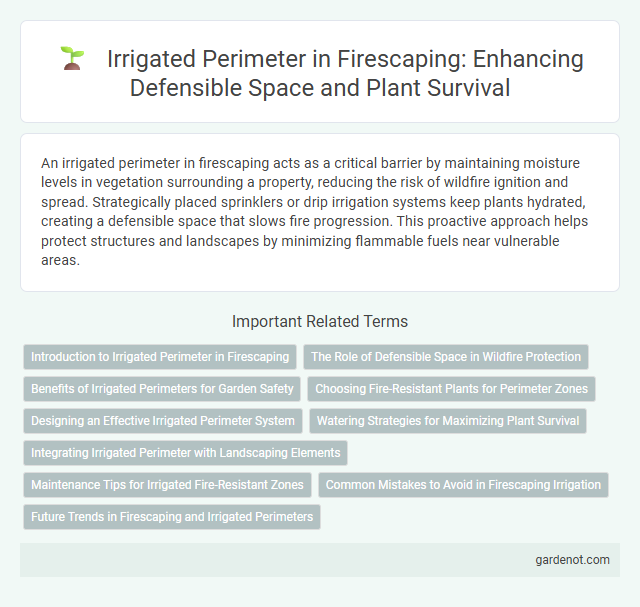An irrigated perimeter in firescaping acts as a critical barrier by maintaining moisture levels in vegetation surrounding a property, reducing the risk of wildfire ignition and spread. Strategically placed sprinklers or drip irrigation systems keep plants hydrated, creating a defensible space that slows fire progression. This proactive approach helps protect structures and landscapes by minimizing flammable fuels near vulnerable areas.
Introduction to Irrigated Perimeter in Firescaping
An irrigated perimeter in firescaping serves as a critical defense mechanism by maintaining a moist barrier around structures to reduce wildfire risk. This technique involves strategically placed irrigation systems that keep vegetation hydrated, slowing fire spread and protecting property. Incorporating drought-resistant plants within the irrigated perimeter enhances fire resilience while optimizing water use efficiency.
The Role of Defensible Space in Wildfire Protection
Creating an irrigated perimeter serves as a vital component of defensible space by maintaining moisture levels that reduce the chances of wildfire ignition and spread. Strategically placed irrigation systems around a property help create a green buffer that deprives fire of fuel, enhancing overall wildfire protection. Properly managed irrigated zones support vegetation health and minimize dry, combustible materials within critical firebreak areas.
Benefits of Irrigated Perimeters for Garden Safety
Irrigated perimeters create a moist barrier that significantly reduces the risk of wildfires spreading into garden areas by maintaining high soil and plant moisture levels. This strategic landscaping technique helps protect valuable vegetation and structures while enhancing the overall resilience of the property against fire damage. Implementing an irrigated perimeter is a proven method for increasing garden safety in fire-prone regions through consistent water application.
Choosing Fire-Resistant Plants for Perimeter Zones
Selecting fire-resistant plants for irrigated perimeter zones enhances defensible space around properties by reducing flammable vegetation. Opt for species with high moisture content, low resin, and minimal leaf litter, such as succulents, ornamental grasses, and certain deciduous shrubs that thrive with consistent watering. Maintaining these plants within the irrigated perimeter creates a live barrier that slows fire spread and protects structures from wildfires.
Designing an Effective Irrigated Perimeter System
Designing an effective irrigated perimeter system for firescaping involves strategically placing drip irrigation or micro-spray emitters along property boundaries to maintain high moisture levels in vegetation, reducing fire risk. Selecting drought-tolerant yet fire-resistant plant species and ensuring consistent water delivery during dry seasons optimize soil moisture retention and create defensible spaces around structures. Incorporating smart irrigation controllers and moisture sensors enhances efficiency by adapting watering schedules to real-time weather conditions, minimizing water waste while maximizing fire prevention benefits.
Watering Strategies for Maximizing Plant Survival
An irrigated perimeter creates a vital water buffer around a property, enhancing fire resistance by sustaining plant health and moisture levels. Implementing targeted watering strategies such as deep, infrequent irrigation encourages deep root growth, improving drought tolerance and increasing plant survival during fire events. Utilizing drip irrigation systems minimizes water waste and ensures consistent moisture delivery, optimizing resource efficiency and fire protection.
Integrating Irrigated Perimeter with Landscaping Elements
Integrating an irrigated perimeter with landscaping elements enhances fire-resistant properties by maintaining moisture levels in vulnerable areas. Strategic placement of drought-tolerant plants alongside irrigation systems reduces fuel load while supporting healthy vegetation growth. This coordination between irrigation and landscape design creates a balanced barrier that minimizes fire risk and promotes ecological sustainability.
Maintenance Tips for Irrigated Fire-Resistant Zones
Maintaining an irrigated perimeter in fire-resistant zones ensures continuous moisture, reducing vegetation flammability and enhancing fire protection. Regularly inspect irrigation systems for leaks, clogs, and proper coverage to keep plants healthy and soil adequately moist. Prune dead or overgrown vegetation and remove combustible debris to maintain optimal fire-resistant landscaping efficacy.
Common Mistakes to Avoid in Firescaping Irrigation
Overwatering the irrigated perimeter can create excessive moisture that fuels wildfire risks instead of preventing them. Using inappropriate sprinkler types or improperly placed heads leads to uneven coverage, leaving vulnerable dry spots in the fire-resistant barrier. Neglecting regular maintenance and seasonal adjustments reduces irrigation efficiency, undermining the effectiveness of the firescaping strategy.
Future Trends in Firescaping and Irrigated Perimeters
Future trends in firescaping emphasize the integration of advanced irrigation technologies to create efficient irrigated perimeters that act as effective firebreaks. Smart irrigation systems using soil moisture sensors and automated controls optimize water usage while maintaining vegetation health to reduce fire risk. Innovations in drought-resistant plant palettes combined with precision irrigation are set to enhance the resilience and sustainability of firescaping practices.
Irrigated perimeter Infographic

 gardenot.com
gardenot.com